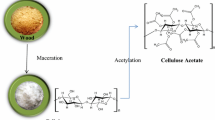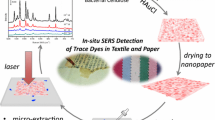Abstract
This paper describes preparation of composite thin films of 12 ± 1 µm from cellulose acetate (CA) and cellulose acetate (CA) -cellulose nitrate (CN) blend on a polyester support for solid state nuclear track detection (SSNTD) application. Films were prepared using a spin coater and their experimentally observed film thickness was compared with theoretically predicted film thickness using Damon and Meyerhofer equations. Effect of RPM of spin coater on cellulose nitrate and cellulose acetate thin films is reported for the first time. Track detection properties of CA + CN are tested and compared with indigenous CN and imported LR-115™ film.




Similar content being viewed by others
References
Fischer S, Thümmler K, Volkert B et al (2008) Properties and applications of cellulose acetate. Macromol Symp. https://doi.org/10.1002/masy.200850210
Kutowy O, Sourirajan S (1975) Cellulose acetate ultrafiltration membranes. J Appl Polym Sci. https://doi.org/10.1002/app.1975.070190525
Ahmad-Fouad Basha M, Morsi Mohamed Morsi R (2017) Spectroscopic, electrical, and relaxor-like properties of cellulose acetate–erbium (III) chloride composite films. J Appl Polym Sci. https://doi.org/10.1002/app.45220
Mohan T, Kargl R, Tradt KE et al (2015) Antifouling coating of cellulose acetate thin films with polysaccharide multilayers. Carbohydr Polym. https://doi.org/10.1016/j.carbpol.2014.04.068
Amim J, Kosaka PM, Petri DFS (2008) Characteristics of thin cellulose ester films spin-coated from acetone and ethyl acetate solutions. Cellulose. https://doi.org/10.1007/s10570-008-9213-9
Morgan E (2013) Eyeglass frame materials. https://www.allaboutvision.com/eyeglasses
Production properties and applications of cellulose acetate. https://www.slideshare.net/SmartinfosysSeo
Nadkarni VS, Bhagwat SS, Samant SD (1999) A correlation of the thickness of the nitrocellulose films prepared using a spinning disk technique with the observable properties of nitrocellulose solution. Indian J Chem Sect A Inorg Phys Theor Anal Chem 38:209–218
Tripathy SP, Mishra R, Dwivedi KK et al (2003) Response of cellulose detectors to different doses of 62 MeV protons. Radiat Eff Defects Solids 5:2. https://doi.org/10.1080/1042015031000099753
El-Fiki MA, Kenawy MA, El-Adl EH et al (1984) Charged particle tracks in plastics. Nucl Tracks Radiat Meas 5:2. https://doi.org/10.1016/0735-245X(84)90178-9
Damon GF (1967) Proceedings Kodak seminar on micro emulsion. New York, p 36
Meyerhofer D (1978) Characteristics of resist films produced by spinning. J Appl Phys 5:2. https://doi.org/10.1063/1.325357
ASTM D 823-95 Standard practices for producing films of uniform thickness of paint, Varnish, and related products on test panels (2007)
Norbeck E, Dubbs TP, Sobotka LG (1987) Spin coating thin films of plastic scintillator. Nucl Instrum Methods Phys Res Sect A Accel Spectrom Detect Assoc Equip. https://doi.org/10.1016/0168-9002(87)90901-6
University of Louisville (2013) Spin coating theory. https://louisville.edu/micronano/files/documents/standard-operating-procedures/SpinCoatingInfo.pdf/view, pp 2–3
Brydson JA (1989) Plastic materials, 5th addition. Butterworths, UK
Acknowledgements
The authors thank The Atomic Energy Regulatory Board, Government of India, for providing research grants and fellowship to V. M. Pawar. Authors thank M/s Rathi Dye Chem (P) LTD, India for gifting a sample of Rathipon fire RED G dye.
Author information
Authors and Affiliations
Corresponding author
Additional information
Publisher's Note
Springer Nature remains neutral with regard to jurisdictional claims in published maps and institutional affiliations.
Rights and permissions
About this article
Cite this article
Pawar, V.M., Nadkarni, V.S. Preparation of thin films of cellulose acetate-nitrocellulose blend for solid state nuclear track detection using spin coating technique. J Radioanal Nucl Chem 323, 1329–1338 (2020). https://doi.org/10.1007/s10967-019-06931-w
Received:
Published:
Issue Date:
DOI: https://doi.org/10.1007/s10967-019-06931-w




